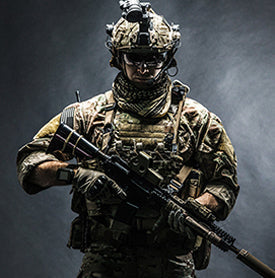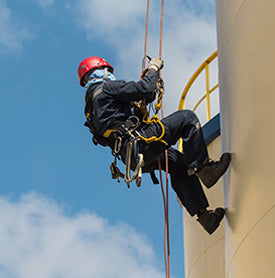When it comes to retaining your gear, not all lanyards are created equal. The material used in your lanyard plays a critical role in how well it performs — especially in high-stress, high-risk environments. At Koiled, we’ve spent decades perfecting our Kevlar coil lanyards because we believe in using the strongest, most reliable materials available.
Nylon might be common, but Kevlar is elite. In this article, we’ll break down the key differences between Kevlar and nylon lanyards, and why Kevlar is the superior choice for professionals and serious users alike.
Kevlar’s Unmatched Strength-to-Weight Ratio
Kevlar is an aramid fiber known for its incredible tensile strength and durability. Pound for pound, Kevlar is five times stronger than steel — yet it’s lightweight and flexible, making it ideal for retention cords and coil lanyards. Koiled’s lanyards have a breaking strain of 265lbs, far exceeding what nylon lanyards can typically withstand.
When you're trusting a lanyard to keep a sidearm, tool, or radio secured, strength isn’t just a feature — it’s essential. Nylon can stretch, fray, or snap under pressure. Kevlar holds strong, even when pushed to its limits.
Superior Resistance to UV, Moisture, and Abrasion
One of Kevlar’s biggest advantages over nylon is its resistance to environmental stress. Nylon can absorb moisture, degrade in UV light, and suffer from long-term abrasion damage. Kevlar, on the other hand, resists all of the above — maintaining its integrity even in harsh conditions.
Whether you're operating in a desert, jungle, or frozen mountain environment, Kevlar performs consistently. This makes it ideal for military, law enforcement, outdoor adventure, and industrial work, where equipment failure is not an option.
Real-World Testing: Breaking Strain vs. Practical Use
Many lanyard manufacturers promote their products with lab-based tensile strength numbers, but real-world performance is what matters. Koiled lanyards have been used for over 30 years by elite professionals — from special forces and SWAT teams to utility engineers and rescue workers.
The coil design, hardware attachments, and Kevlar core all work together to ensure durability and safety in real-life scenarios. Compared to nylon, which tends to weaken with repeated flexing or knotting, Kevlar lanyards retain their shape and resilience over time.
When Nylon Fails and Kevlar Holds
There’s a reason cheap nylon lanyards are often found broken at the bottom of tool bags or tangled up after a few uses — they’re not made for critical applications.
Nylon stretches, kinks, and frays, especially when exposed to dirt, oil, or the elements.
Kevlar lanyards don’t just survive — they thrive in these conditions. If you’ve ever lost a tool down a scaffold, dropped a flashlight into a river, or watched a radio hit the ground mid-operation, you know how costly lanyard failure can be. Koiled lanyards are designed to prevent exactly that.
Conclusion: Invest in What Holds
Choosing the right lanyard isn’t just about convenience — it’s about safety, performance, and peace of mind. Kevlar outperforms nylon in every meaningful way: strength, durability, resistance, and reliability.
Whether you're securing tactical gear, electronic devices, or mission-critical tools, Koiled Kevlar lanyards deliver professional-grade retention that you can count on. Explore our product lineup today — and never compromise on what holds your gear.



